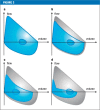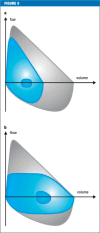The diagnosis of chronic obstructive pulmonary disease
- PMID: 25556602
- PMCID: PMC4284520
- DOI: 10.3238/arztebl.2014.0834
The diagnosis of chronic obstructive pulmonary disease
Abstract
Background: Estimates of the prevalence of chronic obstructive pulmonary disease (COPD) in Germany range from 1.9% to 13.2%, depending on the population studied and the investigative methods used. About 30% of all patients already have severe airway obstruction by the time the condition is diagnosed.
Methods: Review of pertinent literature retrieved by a selective search, including current guidelines and textbooks.
Results: Smoking is the main risk factor for COPD. The diagnosis is based on characteristic symptoms that patients at risk should be actively asked about-cough, dyspnea, diminished physical reserve, and frequent airway infections-together with abnormal pulmonary function tests. Spirometry usually suffices to document impaired air flow. The clinical evaluation and the treatment strategy are based on the severity of airway obstruction and dyspnea, and the frequency of exacerbations. According to a European study, dyspnea is present in 73% of persons with severe COPD, expectoration in 64%, cough in 59%, and wheezing in 42%. Asthma, congestive heart failure, and interstitial lung disease are the main differential diagnoses.
Conclusion: COPD may begin with symptoms that are only mild at first even in a longstanding smoker. The available diagnostic techniques need better prospective validation with respect to relevant endpoints, including mortality, symptom progression, quality of life, and frequency of exacerbations.
Figures





Comment in
-
Occupational preventive measures.Dtsch Arztebl Int. 2015 Aug 17;112(33-34):561-2. doi: 10.3238/arztebl.2015.0561b. Dtsch Arztebl Int. 2015. PMID: 26356554 Free PMC article. No abstract available.
-
In reply.Dtsch Arztebl Int. 2015 Aug 17;112(33-34):562. doi: 10.3238/arztebl.2015.0562b. Dtsch Arztebl Int. 2015. PMID: 26356556 Free PMC article. No abstract available.
References
-
- Ciba Foundation Guest Symposium Terminology, definitions, and classification of chronic pulmonary emphysema and related conditions a report of the conclusions of a Ciba guest symposium. Thorax. 1959;14:286–299.
-
- Mannino DM. Chronic obstructive pulmonary disease: definition and epidemiology. Respir Care. 2003;48:1185–1193. - PubMed
-
- Tashkin DP. Variations in FEV1 decline over time in chronic obstructive pulmonary disease and its implications. Curr Opin Pulm Med. 2013;19:116–124. - PubMed
Publication types
MeSH terms
LinkOut - more resources
Full Text Sources
Other Literature Sources
Medical

